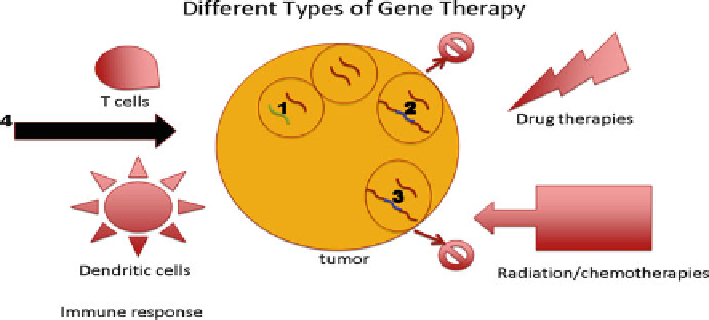Biomedical Engineering Reference
In-Depth Information
Fig. 1
Gene therapy and immunotherapy treatments. As denoted by the numbers in the figure:
(1) Replace missing or mutated genes with healthy genes. (2) Insert genes into tumors that act like
suicide bombs once they are turned on by drugs (3) Insert genes that make tumors more susceptible
to treatments such as chemotherapy and radiotherapy. (4) Augment the immune response to cancers
by enhancing the ability of immune cells, such as T cells and dendritic cells, to fight cancer cells
of cancer is still in its infancy, although there are some successes when the cancer is
detected early enough. To begin to address these important issues, in this work we
will focus solely on genetic issues related to cancer so that we can explore a new
treatment area known as gene therapy as a viable approach to treatment of cancer.
Genes are located on chromosomes inside all of our cells and are made of
DNA. Humans have approximately 35,000 genes. Gene therapy is an experimental
treatment currently being tested in clinical trials that involves introducing additional
genetic material (either DNA or RNA) into cells to fight cancer in a few different
ways. There are several gene therapy approaches that are being explored. First,
scientists are attempting to use gene therapy to replace missing or mutated genes
with healthy genes (for example, p. 53, [
14
]). Second, scientists are attempting
to put genes into tumors that act like suicide bombs once they are turned on by
drugs that are administered to the patient [
53
]. Similar to the suicide genes, a
third approach is to insert genes that make tumors more susceptible to treatments
such as chemotherapy and radiotherapy. And finally, gene therapy is being used
to improve the immune response to cancers by enhancing the ability of immune
cells, such as T cells, to fight cancer cells [
42
]. Figure
1
summarizes these different
gene therapies. Not surprising, gene therapy research has continued to include other
genetics manipulations of gene expression through delivery of modified genes, short
pieces of RNA known as siRNA [
5
], naked plasmid DNA, and even viruses as
vectors for delivery of genetic material into cells. To reduce the risks of side effects,
specific tissues and cell types must be targeted. Not only is the type of gene therapy

Search WWH ::

Custom Search